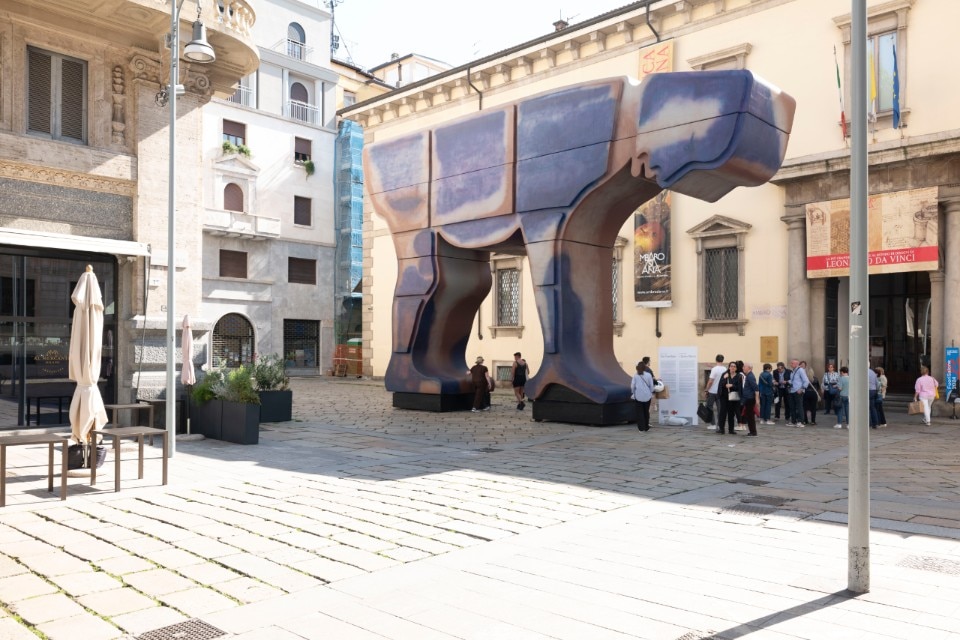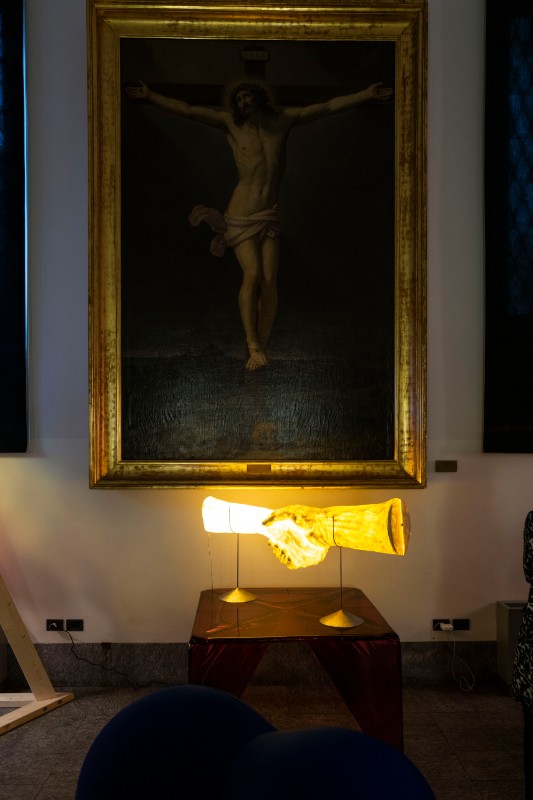Arriving in Piazza Pio XI in Milan is exciting. Standing in front of the façade of the Veneranda Biblioteca Ambrosiana is the sculpture L’Uomo stanco. The figure commands attention amidst the second row of windows, with its recumbent head gazing down and through the entrance door. A monumental silhouette, towering 8 meters high and stretching 13.50 meters long, in a palette of pale blue, grey, and earthy tones.
The posture evokes the idea of a submissive, resigned, humiliated, silent man. It tells us of the decay of the noblest human qualities for the sake of attaining power as a function of satisfying one’s own interests.
The weariness Pesce depicts goes beyond mere physical exhaustion; it speaks to the existential weariness inherent in the male condition, crushed under the weight of its own power, especially in this time and in this world.

The West is tired, power is tired, masculinity is tired: this is what Gaetano Pesce’s latest work suggests – a work that unintentionally assumes a testamentary role. Gone is the formal exuberance and chromatic vivacity of all his previous works, this installation appears restrained, almost paralyzed, and suffused with gray tones – a symbolic reflection of our epoch, conveying a poignant message in its own subdued way. The weariness Pesce depicts goes beyond mere physical exhaustion; it speaks to the existential weariness inherent in the male condition, crushed under the weight of its own power, especially in this time and in this world.
However, stepping inside the entrance gallery of the Ambrosiana presents a markedly different atmosphere. Here, the exhibition Nice to See You unfolds, showcasing approximately 30 works, the majority of which are unpublished. While some pieces hail from the past, the collection predominantly features creations spanning from 2023 to 2024.

Upon entering the exhibition hall, one is immediately greeted by a surge of vitality that fills the void left by Pesce’s passing – a kaleidoscope of colors and a torrent of forms that simultaneously exude energy and deliver well-aimed punches to the gut.
There is a clear sense of design entering the realm of art: these works are not mere objects; they serve as conduits for messages, also and above all designed to make us think.
At the entrance, on an easel, Gaetano Pesce’s invitation to the exhibition – a triangle in resin with a central eye, all the text in relief, wrapped in oiled paper in a brown paper envelope – is reimagined by the students of the bread-making course of the Società Umanitaria. In homage to Pesce, they recreate the invitation on a larger scale, replacing the resin with bread, one of mankind’s most primordial ingredients, as if to bridge the gap between the distant past and the contemporary world.

Moving deeper into the exhibition, visitors encounter the striking orange-amber hues of the Origami Table, an astonishing creation born of fossilized organic matter that evokes a sense of ancestral concreteness. Crafted like an intricate origami fold, the table’s structure emerges from meticulously folded sheets, each fold serving a structural purpose. Achieving this masterpiece requires synergy, communion, and acute attention to the material and its reactions. Every participant in the process must synchronize their actions, pouring resin into molds with coordinated precision to prevent collapse or premature solidification of the material.
But the real protagonist of Gaetano Pesce’s latest exhibition is undoubtedly the body, a body that pulsates, reveals itself, clutches everywhere. Beginning with the hands that come together in Friend Lamp, seemingly seeking to reunite after the forced separations of the pandemic era. Then, in Il pugno (si è dischiuso etc…) sofa, two oversized hands linked by a metal chain symbolize the struggle for freedom of speech in many corners of the globe, reflecting the absence of freedoms experienced by prisoners. In addition, in Il Guanto and La Mano, echoes of Gaetano Pesce’s designs from the early 1970s are revisited with contemporary materials and technologies. Il Guanto serves as a reminder of the importance of touch, reflecting Pesce’s innate intelligence as he worked with his hands, often getting them dirty in the creative process. Conversely, La Mano remains unfinished, with lifelines and two wedding rings raised in relief, offering a glimpse into Pesce’s recurring motif of unfinished narratives in his work.

The exploration of the body continues with the Ear Shelf and Nose Shelf bookshelves, in which the recognizable anatomical shapes of the ear and nose serve to convey simple yet profound messages. These designs evoke a synaesthetic allure long associated with Pesce’s work – a desire to fully engage the senses. Pesce’s intention is to counteract the sensory numbness prevalent in contemporary society, where smells and tastes are erased, flavors are homogenized, and sounds are stifled. He challenges the binary of comfort and aims to awaken perceptual experiences. (Pesce’s commitment to engaging the senses dates back to 1975, when he collaborated with a perfumer at the Musée des Arts Décoratifs in Paris to create an essence that resembled mold. This scent was to be sprayed daily by visitors, challenging the notion of museums as stagnant, lifeless spaces – a message conveyed through the most primal of senses.)
The culmination of this exploration, however, is manifested in Il Vaso più indispensabile, a tribute to the greatest creator in the universe: the womb, the cradle of existence itself. This vase, one of Pesce’s iconic objects reinvented in countless surprising variations, embodies its original essence and essential role not only as a vessel but as the generator of life itself. Similarly, the essence of creation bursts forth in the silhouette of Mother with Son (Project of a Door), a design conceived in the 1990s for the interior of a children’s clothing store and draws on the iconography of Renaissance art, in particular the Madonna and Child.

And then there are the faces, the eyes, the mouths in the Do I Like You? table, alongside the latest chair collection: La Grande, La Cugina, Il Bambino, La Piccola. These creations, conceived just days before his passing, delve into the dynamics of familial interactions, exploring various sitting postures, and celebrating the everyday smiles of life.
Then there are Pesce’s oversized triumphs, the domestic monuments that objects become: Dalila Chair XL, Nobody’s Perfect XL, and l’Oman Trono – a product of his trip to Oman, inspired by the country’s rich perfumery heritage, particularly the resin of incense. Then there’s the enchanting play of colors, transparencies and lights in pieces like the Luigi (o mi amate voi?) bookcase, reintroduced by Bottega Ghianda, which showcases Pesce’s ability to transform the mundane into a “chamber of wanders.”

Far from being tired, Gaetano Pesce remained a fighter until his last breath – polished, volcanic, angry and yet remarkably tender. His legacy of thought and vision lives on through his work. His final exhibition serves as a reminder that, unlike those who view design as a means to confine and constrain the world within rigid geometric forms, Pesce embodied the opposite pole: he sought to liberate the forms of the world by shattering dogmas, prejudices, clichés, and hierarchies. His mission was to set us free, as free as he was.











